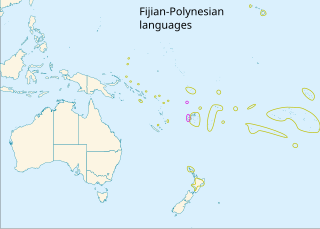Related Research Articles

RatuSeru Epenisa Cakobau was a Fijian chief, monarch, and warlord (Vunivalu) who united part of Fiji's warring tribes under his leadership, establishing a united Fijian kingdom. He was born on Natauloa, Nairai Island in Lomaiviti but spent his youth on Vanuaso, Gau, Lomaiviti, later returning to Bau to re-establish his Father's Ratu Tanoa Visawaqa reign. Ratu Epenisa Seru Visawaqa was given the name "Cakobau" meaning destroyer of Bau, in reference to his grandfathers' (Nailatikau) effort to first claim the tile from the people of Butoni and Lovoni, returned with most of his warriors from Vanuaso, Gau, Lomaiviti to coup the leadership in Bau then and later takeover his father's title; known after his father as the 6th "Vunivalu" or Warlord of Bau.

The Central Pacific languages, also known as Fijian–Polynesian languages, are a branch of the Oceanic languages spoken in Fiji and Polynesia.

The Eastern Division of Fiji is one of Fiji's four divisions. It consists of Kadavu Province, Lau Province, Lomaiviti Province and Rotuma.

Ovalau is the sixth largest island in Fiji. It is located in Lomaiviti Archipelago. Situated at 17.70° South and 178.8° East,, the island is about 13 kilometers long and 10 kilometers wide. It covers a total area of 106.4 square kilometers and has a population of around 9,100, approximately half of the population of Lomaiviti Province over the 1956–2007 period. Levuka, Fiji's former capital, is the largest of 24 towns and villages on the island, and is the only urban area in Lomaiviti. All settlements are coastal, except Lovoni in the interior of the island.

The Lomaiviti archipelago of Fiji consists of seven main islands and a number of smaller ones. They cover a total area of 411 square kilometres (159 sq mi), and had a population of 15,657 at the most recent census in 2017. The largest town, with a population of 1,131 in 2007, is Levuka, which was Fiji's first modern town and served as the capital from 1871 to 1877.
Yanuca Levu is a hilly steep islet in Fiji's Lomaiviti group, within Ovalau reef.

Leleuvia is a coral cay in Fiji's Lomaiviti archipelago. The 68,000 square metres (731,946 sq ft) islet is the site of the Leleuvia Island Resort, previously operated by the Chinese-Fijian businessman Emosi Yee Show. Only in early 2006 has the island been leased by a company called Saluwaki Limited with the intention to refurbish the island resort. Leleuvia Island is popular among beachcombers and kite surfers. There is snorkelling directly off the beach.
The Viti Levu Group is an archipelago in Fiji consisting Viti Levu island and its outliers.

Tailevu South Lomaiviti Open is a former electoral division of Fiji, one of 25 open constituencies that were elected by universal suffrage. Established by the 1997 Constitution, it came into being in 1999 and was used for the parliamentary elections of 1999, 2001, and 2006. It comprised the Lomaiviti Archipelago and the southern part of Tailevu Province, on the main island of Viti Levu.

Lomaiviti Fijian Provincial Communal is a former electoral division of Fiji, one of 23 communal constituencies reserved for indigenous Fijians. Established by the 1997 Constitution, it came into being in 1999 and was used for the parliamentary elections of 1999, 2001, and 2006.. The electorate covered the Lomaiviti Archipelago and was coextensive with Lomaiviti Province.
Batiki is an island of Fiji belonging to the Lomaiviti Archipelago. The island is of volcanic origin, with a land area of about 12 square kilometers. To the north-east is Wakaya Island, to the east is Nairai, and to the south-east is Gau.

Nairai is an island of Fiji belonging to the Lomaiviti Archipelago. The island is of volcanic origin and has a land area of about 30 square kilometers. To the west of the island is Batiki, and to the south-west is Gau.
Filimoni Vakalololma Bolavucu is a Fijian rugby union player, who currently plays for Dax in Pro D2. He plays as a wing. He played for the Suva Highlanders in the Colonial Cup. He also played for Lomaiviti in the local tournaments. He has played in the Top 14 competition in France representing Brive and Bayonne.
Levuka Airfield is an airport on the island of Ovalau, one of the Lomaiviti Islands in Fiji. Also well known as Bureta Airport, it is located 22 kilometres (14 mi) from the town of Levuka. and operated by Airports Fiji Limited.
Koro Airport is an airport serving Koro, one of the Lomaiviti Islands in Fiji. It is operated by Airports Fiji Limited.
Gau Airport is an airport on Gau Island, one of the Lomaiviti Islands in Fiji. It is operated by Airports Fiji Limited.
J. B. Tularam was a Fiji Indian member of the Legislative Council of Fiji elected from the Eastern Constituency in 1937 by defeating Channa Bhai Patel by 14 votes. The constituency was made up of the provinces of Lomaiviti, Lau, Cakaudrove and Macuata. He was a member of the Council until 1944.
Atunaisa Kaloumairai is a former Fijian politician. He was a member of the Senate of Fiji and represented Lomaiviti Province.
Lomaiviti Province is one of the 14 provinces of Fiji. Administratively, it forms part of Fiji's Eastern Division and of the Kubuna Confederacy, one of three traditional chiefly hierarchies in Fiji.
Lomaiviti may refer to:
References
- ↑ Lomaiviti at Ethnologue (18th ed., 2015) (subscription required)